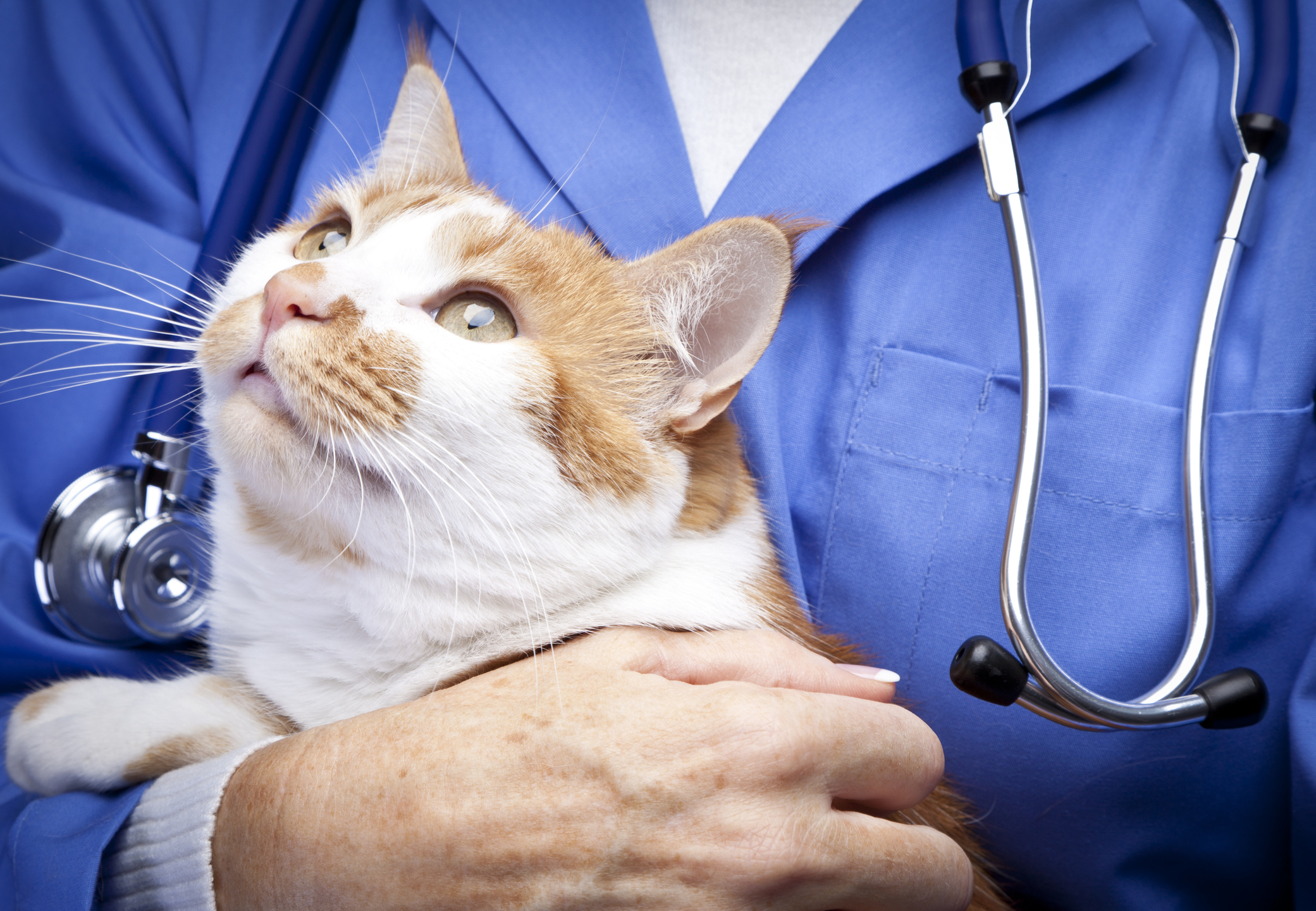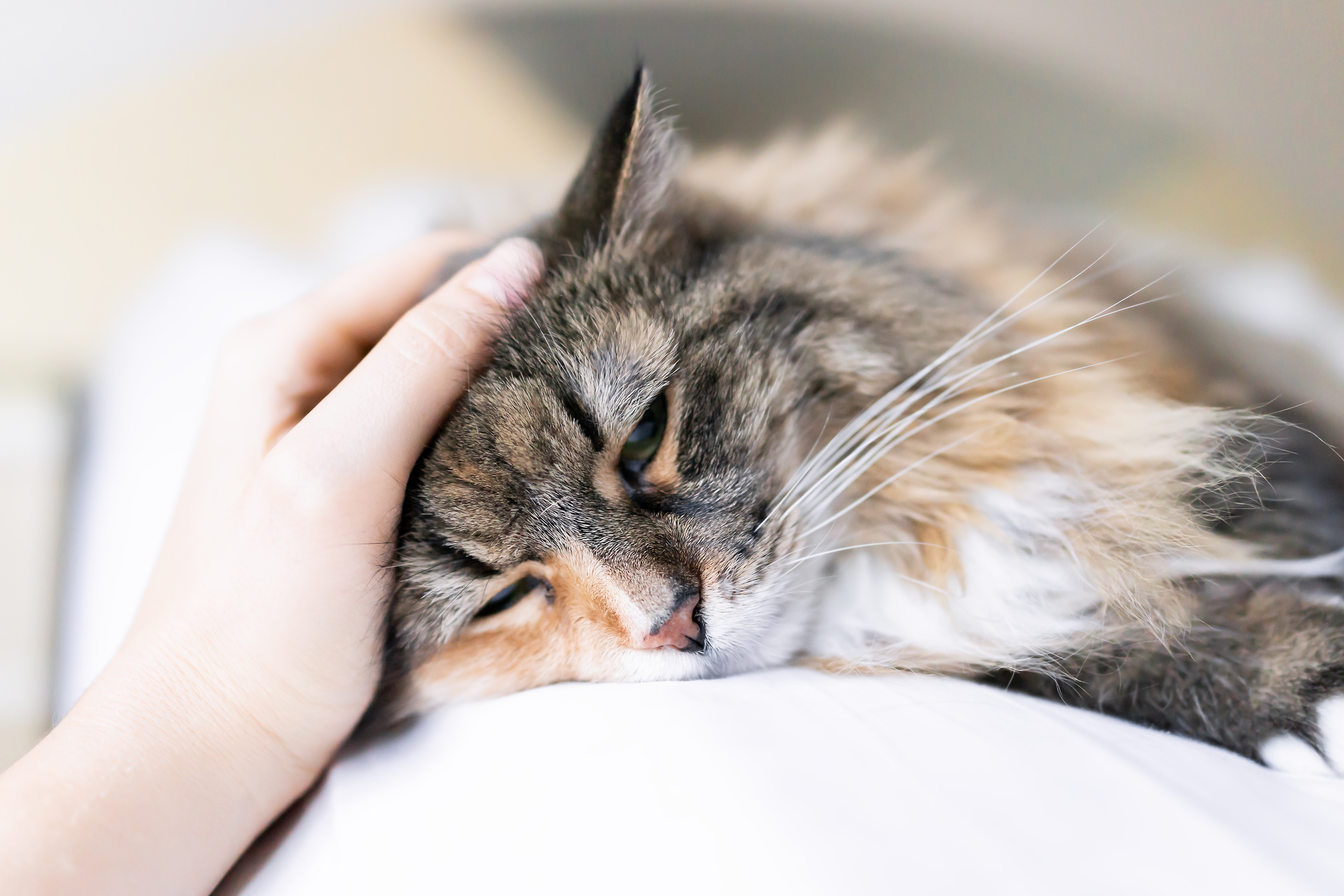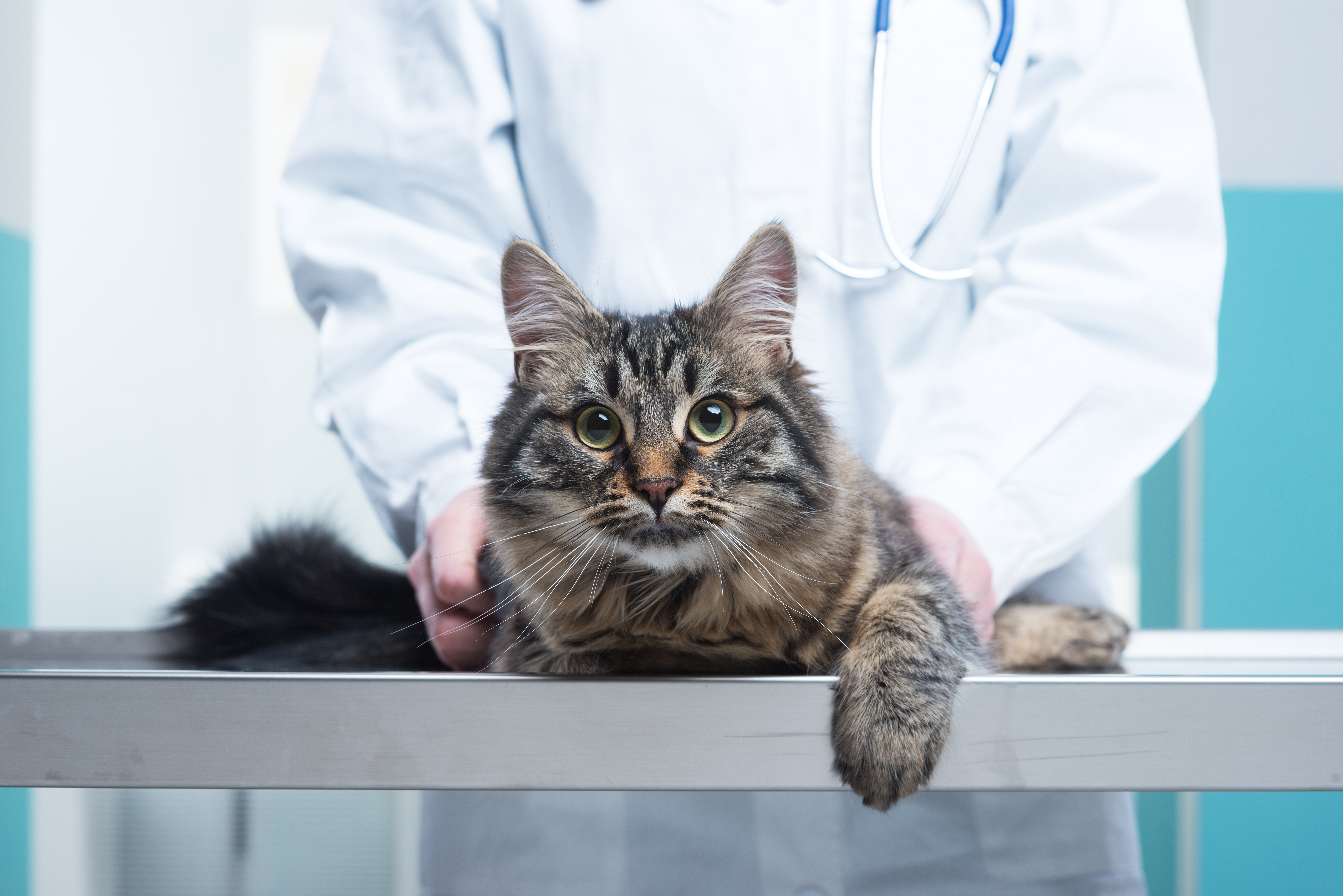
Everything You Ever Wanted to Know About Cat Cancer
The word “cancer” strikes fear into the hearts of all pet owners. It’s the very last thing that you want to hear your veterinarian say when you take your beloved feline companion in for a problem. It can come as a surprise since our cats are masters of disguising their pain and discomfort, and you may be left wondering: “What do I do next?”
Table of Contents
Cancer in cats doesn’t occur as frequently as it does in dogs, but regardless it still occurs more than anyone would like. In fact, cat cancers can even be more aggressive when they do happen. This is why it's so important to understand cat cancer as thoroughly as possible in case you are ever given the horrible news.
Even though things may not look great right now, there is so much hope for you cat. Pet owners these days are given several options to confront cancer treatment, and they can range from typical medical treatment like chemotherapy and surgery to more alternative methods.
Advocate for your pet, do your research, and stay strong, because he or she needs you the most right now.
Ebook Download offer (coming soon!)
**Needs Design, pending on Ebook design**
Download our quick reference guide to all the canine cancer information on this page, and access it on-the-go or whenever you need it.
1. What is Cancer?
Cancer, also called neoplasia, is the term given to a group of diseases that all have a common characteristic: they are the result of abnormal cells that begin to divide rapidly and overtake a certain tissue or system in the body. Often, these cells also metastasize, or begin to invade surrounding tissues or move through the bloodstream to be introduced to different body systems.
The beginnings of cancer result from a damaged cell that begins to rapidly multiply in turn. This damage is the result of an overwhelming amount of “free radicals”. Free radicals are unstable molecules that are aggressively trying to stabilize themselves by stealing electrons from other surrounding molecules. This continuous process creates a growing number of new free radicals. Until free radicals are stabilized through antioxidant treatment, they will continue to grow in number and eventually cause damage to the body’s cells.
There is a normal amount of free radicals normally present in the body, but tend to accumulate with age. Free radicals can increase when we are exposed to radiation, cigarette smoke, herbicides and toxic chemicals including many household cleaners and outdoor pollution. Without antioxidant treatment, they can develop to a point that is out of control and dangerous.

Causes of Feline Cancer
Cancer in cats is caused by a group of factors. There is not one single cause of cancer, but rather a family of contributing influences that triggers it. Most of the time, hereditary and environmental factors work together to bring about the development of cancer. Feline transmissible viruses, especially feline leukemia virus, can also contribute to certain cancer types in cats.
Genetic Factors
Just like their people, cats can have a familial history of disease. Unfortunately not all of us can trace our cat’s genetics back to individuals and we have to rely on the information that we have for certain breeds.
Environmental Factors
Cancerous risk factors can be present in a cat’s diet or in the environment. Different animals will display different sensitivities to particular risk factors. A pet parent should do well to generally avoid all well known cancerous agents.The same kind of carcinogens that we link with human cancer can impact our canines
- Ultraviolet radiation from the sun
- Second hand smoke
- Herbicides/pesticides
- Air pollution/smog
- Asbestos, radon, uranium, etc.
Weight
Our cats love food. Plain and simple. But an overweight cat has a greater chance of experiencing too much glucose, insulin sensitivity, inflammation, and oxidative stress, which are all factors in cancer. An obese cat is are a much greater health risk than a cat at a normal weight. Restricting the amount of calories your cat eats can prevent or delay the advancement of certain forms of cancer.
Advanced Age
Aging pets experience a weakening immune system and a higher risk of malignant cells, leading to a higher likelihood of cancer in older cats. Symptoms will be noticeable and should be dealt with as seriously as possible. The longer a pet lives the longer it is exposed to environmental cancerous risk factors, increasing his or her risk significantly.
Breeds and Genders of Cats Most Commonly Affected by Cancer
Certain breeds of cats are more prone to particular types of cancers than others. Unfortunately, among cats there is far less breed-specific data on cancer risk. It is accepted that purebred cats are generally believed to be more susceptible to cancer than their non-purebred cohorts - this is mainly true in Persians, Bengals, and Siamese cats.
These certain forms of cancer are much more commonly found in the following breeds, age, and sex of cats:
- Squamous Cell Carcinomas - Siamese cats and others with lightly-pigmented skin are more prone to skin cancers and tumors.
- Lymphosarcoma - Often seen in cats between the ages of two and six, outdoor cats at this age are more likely to be exposed to and contract feline leukemia virus which can trigger lymphosarcoma.
- Mammary Cancer - Males and females generally develop most cancers at an equal rate, but female cats, especially those that are not spayed or spayed late, are predisposed to mammary cancer.
2. How Will Cancer Show Up in My Cat?
Even though the causes of cancer are very similar between cats, dogs, and even humans, there are forms of cancer that cats are predisposed to over others. Understanding what your cat is going through can help give you peace of mind and make the best decisions.

Most Common Forms of Cancer in Cats
Cats will develop cancer differently from other pets as they are uniquely predisposed to certain conditions. For example, many forms of cat cancer are the result of feline leukemia virus infections, that only cats uniquely experience. While these forms of cancer do appear in various animal species, the following shows how these common conditions specifically can affect a cat's system.
- Lymphoma: This type of cancer is the most commonly-diagnosed in cats, and it affects the lymphatic system. This system carries immune products throughout the body to fight infections and diseases. The most common sites for the development of lymphoma in cats are the GI tract, liver, spleen, and kidneys. Lymphoma is can be associated with feline leukemia virus infection in cats.
- Basal cell tumor: This is a common type of skin cancer in cats. It usually appears as raised, round, pigmented masses on the skin. These tumors may be benign (non-aggressive, non-spreading) or malignant (aggressive, causing damage, and possibly spreading). Only surgical removal and biopsy can determine which type is present.
- Squamous cell carcinoma: This highly aggressive form of cancer affects the skin, usually light or areas without pigment that can be damaged by the sun. It is often found on ear tips or the face of the cat in general. It is also frequently found in cats’ oral cavities.
- Mammary cancer: Similar to breast cancer in people, these tumors occur in a cat’s mammary, or breast tissue. Mammary cancer is most commonly seen in female cats that have not been spayed, and it is usually a type of cancer called adenocarcinoma.
- Mast cell: This type of cancer in cats most commonly occurs in the spleen or on the skin. The skin form of mast cell cancer in cats is often benign, while the splenic form is usually malignant.
- Fibrosarcoma: This type of cancer is extremely aggressive in the area of skin that it affects. It invades the local muscles, ligaments, and sometimes bone. Fibrosarcoma can occur spontaneously or secondarily to feline sarcoma virus. It is also widely accepted that certain vaccinations or any other injections may trigger factors that increase the risk of fibrosarcoma development in cats.
3. What Are the Most Common Signs of Cancer in Cats?
The kinds of symptoms of cancer may show up in our cats vary widely depending on the type of cancer that is involved. Most cancer signs will be directly related to the body system that is affected. For example, a cat with kidney cancer will drink more water, need to urinate more often, and more obvious signs related to kidney function.

Cancer can cause virtually any sign and sometimes no signs at all in cats. It’s important to visit your veterinarian routinely and at the first sign of any change in behavior or body condition.
Some of the general signs that a cat with cancer might show are:
- Lumps or bumps in the skin, under the skin, or protruding from the abdomen. Abdominal masses may be more visible when a cat is lying or sitting in a certain position.
- Bad breath is often present, especially in cases of mouth or kidney cancer.
- Drooling is frequently seen with oral cancer and sometimes also with internal neoplasia.
- Listlessness is common in cats afflicted with cancer. They may not be as interested in playing or getting involved in the household’s activities.
- Decreased appetite and weight loss are seen with most types of cancer but sometimes not until the advanced stages.
- Lameness, or limping, may occur with bone cancer and sometimes cancers of the blood or lymphatic systems.
- Vomiting and diarrhea are often seen in feline cancer cases. These gastrointestinal disturbances may occur secondarily to a wide variety of cancer types.
- Changes in the skin or hair coat may indicate cancer in cats. This often manifests as persistent skin infections, patchy redness or hair loss, raised masses erupting on the skin, or changes in skin color.
- Difficulty breathing or coughing may be a sign of lung or heart cancer. Lung cancer in cats is often secondary to cancer in some other part of the body.
- Behavior changes such as withdrawal and hiding are commonly seen in cats suffering from cancer.
Cats are also great at hiding illnesses, which can even prevent them from showing significant signs of cancer until the condition is quite advanced. A pet parent has to be extra aware and pay close attention to even the slightest changes and signs.
4. How Will My Vet Diagnose and Treat My Cat’s Cancer?
As we have mentioned before, when you start to notice questionable symptoms in your cat that may be associated with cancer, it's time to visit the vet immediately. Depending on the part of the body that appears to be affected, the tests, diagnosis, and prescribed treatment can vary significantly. You vet is very familiar with this process and will only do what they believe is best for your kitty's situation.

Diagnosing Feline Cancer
Depending on the type of cancer and the part of the body it affects, your cat’s cancer diagnosis can either be fairly straight-forward or more complicated. Your vet will ask you for the history of any signs of illness that you have observed at home. Then, once a full physical examination is complete, some or all of the following diagnostic tests may be performed:
- Fine needle aspirate. This is the process of inserting a small needle into a mass and removing some cells to be examined under a microscope. Fine needle aspirates are most often used on skin masses, but they can be done on internal masses when ultrasound technology is used as a guide for inserting the needle.
-
Biopsy. This test involves removing a piece of tissue from a tumor so it can be examined under a microscope. Biopsies can be done in several ways:
- A skin mass may be removed in its entirety for biopsy.
- An exploratory internal surgery can be done, and all of a diseased mass or area can be removed for microscopic examination.
- A small piece of abnormal tissue may be removed for diagnostic purposes because there is too much diseased area to remove entirely or a tumor is in too delicate of an area to attempt removal.
- Complete blood count (CBC). A CBC is a test that is done on blood, and it gives the veterinarian quite a bit of information. Knowledge of a cat’s white blood cell, red blood cell, and platelet numbers and health can all contribute to the diagnosis and prognosis development of a feline cancer.
- Blood chemistry. These blood tests mainly evaluate organ function. It is important to know the general status of a cat’s systems when diagnosing cancer as well as during the process of developing a treatment plan and prognosis.
- X-rays. X-rays, also called radiographs, can be used to diagnose tumors in cats if they are large enough. They can also be helpful in evaluating the general health status of the patient and in looking for potential spread of an already-diagnosed cancer when developing a treatment plan and prognosis.
- Ultrasound. This technology uses sound waves to create pictures of internal body structures. It is useful in diagnosing some tumors that occur inside the chest or abdominal cavity of cats.
- CT scan. This is a type of x-ray that uses a computer to create cross-sections and three dimensional images of body structures. It can sometimes find smaller tumors or detect the spread of cancers into internal tissues more specifically than plain x-rays or ultrasound can.
- MRI. This procedure uses radio waves and magnetic fields to generate images of internal organs and body structures. This is another procedure that can sometimes detect smaller or more widespread cancers or tumors deeper in a cat’s body.
Treatment of Cancer in Cats
Like any cancer diagnosis, there is not one solution for every situation. There are as many types of cancer as there are treatment options. The treatment plan that your vet decides upon depends on the following factors:
- Type of cancer present. Cancer treatment is specific to the type of cancer. Veterinary oncologists are veterinarians who specialize in cancer treatment. Often cats with cancer are referred to one of these specialists for treatment.
- Stage and extent of spread of the disease. Treatment will depend on how advanced the cancer is and how far it has spread in the body.
- Age of the cat. Your cat’s age will play a role in how aggressively the cancer may be treated. Older cats may need gentler treatment courses than younger ones.
- Concurrent health conditions of the cat . If your cat has any other medical issues besides the cancer, the treatment may need to be modified or changed to accommodate that. For instance, using certain chemotherapy drugs in a cat that already suffers from kidney failure may not be possible.
Treatment recommended by your veterinarian may include one or a combination of the following:
- Surgery. Treatment of many types of feline cancers starts with the removal of as much of the visible cancer, or tumor, as possible. Depending on the type of cancer, how advanced it is, and how much the surgeon is able to remove, surgery may be curative in some cases.
- Chemotherapy. Some types of cancer are treated with medications. These may be intravenous (given into a vein) or oral (given by mouth). Chemotherapy is sometimes the first treatment that is used, but it is also often employed after surgery has been done to remove the bulk of a tumor or tumors.
- Radiation therapy. This treatment involves delivering focused beams of some type of radiation directly to a tumor. It is used in conjunction with surgery and/or chemotherapy in some cat cancers. It can also be used to reduce the signs of illness and extend the life of some cats with inoperable tumors or with cancers that aren’t expected to regress completely with other treatment options.
- Immunotherapy. Treatments aimed at stimulating the cat’s immune system to fight the cancer are available for some types of cancer in cats.
- Palliative care. In cases where an owner doesn’t want to pursue cancer treatment for their cat, a cat is too old or otherwise sick to endure treatment, or the cancer is too advanced for treatment to be effective, palliative care may be used. This could include pain medication, fluid administration, anti-nausea medications, and other symptomatic treatments.

Is There a Cat Cancer Cure?
True cancer "cures" are harder to determine, as it is a very specific definition. Before we determine what we mean in the context of cancer, it’s important to understand the difference between a cure and remission:
- Cure: Elimination of all traces of cancerous cells from the body without risk of return.
- Remission: There are few to no signs of cancer in the body.
- Complete remission: There aren’t any detectable signs of symptoms of cancer.
In veterinary medicine, the goal of cancer treatment is entering remission, not curing it. Most often a curative treatment dosage for a cat would lead to extra suffering and illness. With this in mind, in order to maximize the quality of life, veterinarians made remission the main goal of pet cancer treatment. However, veterinary cancer treatment can usually achieve remission, and in fact even cure it in some cases.
5. Are There Alternative Therapies for Cancer in Cats?
Medical treatment for cancer is effective, but it also can take a toll on your sick kitty, potentially causing issues for other systems in the body unrelated to the cancer. In some cases, the treatment alone will not be able to achieve remission or a cure, and the cancer will return. In addition to the possible pit-falls, the cost of treatment can be very expensive to you the pet owner.
What options do we have? Are there alternatives to traditional cancer medicine for cats?
There are a number of holistic methods that can support you cat during his or her cancer recovery. Alternative therapies can't necessarily replace treatment, but they can compliment your vet's treatment plan, making things more effective. Consider any of the following holistic treatments to help maintain your cat's quality of life:
- Antioxidants such as Vitamins C and E and selenium can help neutralize free radicals in the body, minimizing further cell damage from cancer. Intravenous (IV) delivery is the most efficient way for a cat to be given antioxidant therapy.
- Chiropractic and acupuncture therapies are both useful for cats with cancer. They can provide pain management, immune system stimulation, and specific therapy in certain instances.
- Herbs and herbal mixtures may be helpful in detoxifying the body and supporting the immune system when a cat is fighting cancer.
- Homeopathic treatments are used to combat cancer in cats. A veterinarian who is trained in homeopathy should be consulted to obtain the best results with this type of therapy.
- Dietary therapy is a good holistic, natural preferably homemade diet that is high in antioxidants is preferable for cats with cancer. Fish based diets are natural choices for supporting the cat’s immune system and internal organs.

Medicinal Mushrooms for Cats with Cancer
Medicinal mushrooms are unique forms of fungi that pack a powerful therapeutic compound. More and more these specimens are used to treat a variety of immune system related issues. Research has show that certain medicinal mushrooms possess anti-cancer and anti-tumor compounds.
Edible mushrooms all contain various amounts of beta-glucan, an important compound that helps to give mushrooms their health supporting properties. Additionally, mushrooms are rich in polysaccharides, which are complex sugars that are a great source of protein and B vitamins and promote an overall boost in health benefits.
Consider including these common species of medicinal mushrooms into your dog's complementary treatment:
- Turkey Tail - This beautifully shaped polypore has been extensively researched for its significant immune system support, probably more than any other mushroom in the world. In Japan, a derivative of Turkey Tail comprised of polysaccharides is an approved product for cancer treatment.
- Maitake - Another immune-enhancing medicinal mushroom, Maitake has anti-tumor and anti-viral benefits. It has also been studied for its beneficial effects on blood pressure, blood cholesterol, and its ability to help support normal blood sugar. For this reason, we recommend using caution when administering alongside blood-sugar-lowering medication, as Maitake may enhance its effects.
- Reishi - A suitable adjunct to standard cancer therapies, Reishi is also indicated for growths and general inflammation. It is one of the prized "king herbs" for reducing stress, maintaining good energy levels, and balancing hormones.
- Agaricus blazei - This immune-supporting mushroom offers a high content of polysaccharides and cellular-growth supporting compounds, helping to activate the immune system and protect the body from infection and disease.
- Cordyceps - Another mushroom offering strong immune supporting properties, research shows that these species is essential to boost your dog’s health, stave off dangerous diseases, soothe inflammation, and enhance cardiovascular functionality.
-
Shiitake (Lentinula edodes)
These well-known mushroom are extremely rich in amino acids, enzymes and health-supporting minerals like zinc, iron and calcium. They are a great addition to maintaining your dog’s health by stimulating white blood cells and improving circulation.
6. How Should I Care For My Cat During Treatment?
Hopefully, knowing the signs, causes, diagnosis, and treatments associated with feline cancer will help you be prepared if it happens to your beloved cat. During this time it’s not uncommon to feel powerless, but there is a lot you can do at home to ensure your kitty has the best fighting chance for a high quality of life.

- Stay positive: Approach treatment in a calm, collected, and pleasant manner. Our cats’ are very perceptive when it comes to our moods, and you can help them stay content during the struggle ahead.
- Find your own support: Coping with cat cancer is one of the hardest things we can do as pet parents. In order to do your best for your cat you need a support system of your own. Talk to a friend, a relative, or a trusted acquaintance who has been through this before. You're not alone in this and many have come through it successfully before you. Being there for your furry baby is all part of being a pet parent.
- Listen to your vet: Follow the plan set out by your veterinarian and stick to it like glue. If you are curious about other treatment options be sure to speak to your vet first. Maintain communication as they are your best resource for helping you maintain a good quality of life for your cat.
- Complement treatment: Keep your cat happy, healthy, and comfortable. Maintaining a high quality of life during treatment can mean more exercise, a nutritious diet, herbal supplementation, extra attention, and lots of love.
- Put your cat's welfare first: We know you want to do everything you can to beat the cancer, but often aggressive treatment is not always the best option for advanced cancer in older animals. This often means that medical treatment will cause more grief than your cat is ready for. Make sure you are doing the right thing for them and not out of selfish motivations.
- Be realistic: Since our cats hide the pain for so long, we may not know about the cancer until the disease has progressed to a point beyond our control. There may come a time when medical treatment can’t improve a poor prognosis. At this point the goal shifts from directly treating your cat’s cancer to keeping him or her comfortable and content. Make sure to enjoy your time together as best as is possible!


